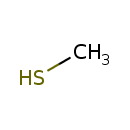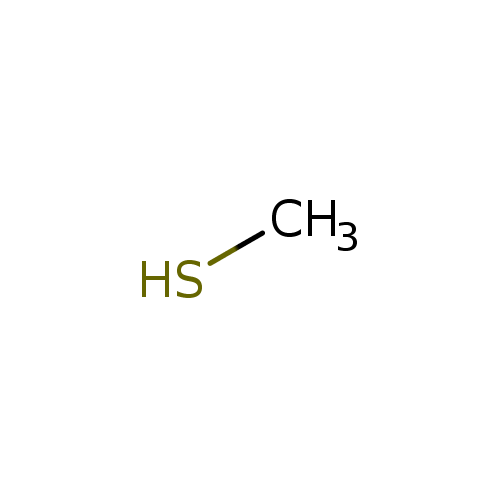|
Record Information |
|---|
| Version |
1.0 |
|---|
| Update Date |
1/22/2018 11:54:54 AM |
|---|
|
Metabolite ID | PAMDB120435 |
|---|
|
Identification |
|---|
| Name: |
methanethiol |
|---|
| Description: | Methanethiol (also known as methyl mercaptan) is a colorless gas that smells like rotten cabbage. It is a natural substance found in the blood, brain, and other tissues of people and animals. It is released from animal feces. It occurs naturally in certain foods, such as some nuts and cheese. It is also one of the main chemicals responsible for bad breath and flatulence. At very high concentrations methanethiol is highly toxic and affects the central nervous system. The chemical formula for methanethiol is CH3SH; it is classified as a thiol. Methanethiol is also considered to be a weak acid, with a pKa of ~10.4. This acidic property makes it reactive with dissolved metals in aqueous solutions. The environmental chemistry of these interactions in seawater or fresh water environments such as lakes has yet to be fully investigated. -- Wikipedia. |
|---|
|
Structure |
|
|---|
| Synonyms: | - Methanethiol
- methanethiol
- Methylmercaptan
|
|---|
|
Chemical Formula: |
CH4S |
|---|
| Average Molecular Weight: |
48.103 |
|---|
| Monoisotopic Molecular
Weight: |
48.003372 |
|---|
| InChI Key: |
LSDPWZHWYPCBBB-UHFFFAOYSA-N |
|---|
| InChI: | InChI=1S/CH4S/c1-2/h2H,1H3 |
|---|
| CAS
number: |
74-93-1 |
|---|
| IUPAC Name: | methanethiol |
|---|
|
Traditional IUPAC Name: |
methanethiol |
|---|
| SMILES: | CS |
|---|
|
Chemical Taxonomy |
|---|
|
Taxonomy Description | This compound belongs to the class of organic compounds known as alkylthiols. These are organic compounds containing the thiol functional group linked to an alkyl chain. |
|---|
|
Kingdom |
Organic compounds |
|---|
| Super Class | Organosulfur compounds |
|---|
|
Class |
Thiols |
|---|
| Sub Class | Alkylthiols |
|---|
|
Direct Parent |
Alkylthiols |
|---|
| Alternative Parents |
|
|---|
| Substituents |
- Alkylthiol
- Hydrocarbon derivative
- Aliphatic acyclic compound
|
|---|
| Molecular Framework |
Aliphatic acyclic compounds |
|---|
| External Descriptors |
- alkanethiol (CHEBI:16007)
- a thiol (CPD-7671)
|
|---|
|
Physical Properties |
|---|
| State: |
Gas |
|---|
| Charge: | 0 |
|---|
|
Melting point: |
-123 °C |
|---|
| Experimental Properties: |
| Property | Value | Reference |
|---|
| Melting Point | -123 °C | Not Available | | Boiling Point | Not Available | Not Available | | Water Solubility | 15.4 mg/mL at 25 °C | Not Available | | LogP | Not Available | Not Available |
|
|---|
| Predicted Properties |
|
|---|
|
Biological Properties |
|---|
| Cellular Locations: |
Not Available |
|---|
| Reactions: | |
|---|
|
Pathways: |
Not Available |
|---|
|
Spectra |
|---|
| Spectra: |
|
|---|
|
References |
|---|
| References: |
- Jiang T, Suarez FL, Levitt MD, Nelson SE, Ziegler EE: Gas production by feces of infants. J Pediatr Gastroenterol Nutr. 2001 May;32(5):534-41. [11429513 ]
- Walker V, Mills GA, Fortune PM, Wheeler R: Neonatal encephalopathy with a pungent body odour. Arch Dis Child Fetal Neonatal Ed. 1997 Jul;77(1):F65-6. [9279187 ]
- Suarez F, Springfield J, Furne J, Levitt M: Differentiation of mouth versus gut as site of origin of odoriferous breath gases after garlic ingestion. Am J Physiol. 1999 Feb;276(2 Pt 1):G425-30. [9950816 ]
- Yaegaki K, Sanada K: Volatile sulfur compounds in mouth air from clinically healthy subjects and patients with periodontal disease. J Periodontal Res. 1992 Jul;27(4 Pt 1):233-8. [1640345 ]
- Suarez FL, Furne J, Springfield J, Levitt MD: Failure of activated charcoal to reduce the release of gases produced by the colonic flora. Am J Gastroenterol. 1999 Jan;94(1):208-12. [9934757 ]
- Jonski G, Young A, Waler SM, Rolla G: Insoluble zinc, cupric and tin pyrophosphates inhibit the formation of volatile sulphur compounds. Eur J Oral Sci. 2004 Oct;112(5):429-32. [15458502 ]
- Hayward NJ, Jeavons TH, Nicholson AJ, Thornton AG: Development of specific tests for rapid detection of Escherichia coli and all species of Proteus in urine. J Clin Microbiol. 1977 Sep;6(3):195-201. [332706 ]
- Johnson PW, Lancero H: Function of gingival fibroblasts and periodontal ligament cells in the presence of methyl mercaptan. Quintessence Int. 1999 May;30(5):343-9. [10635290 ]
|
|---|
| Synthesis Reference: |
Not Available |
|---|
| Material Safety Data Sheet (MSDS) |
Download (PDF) |
|---|
|
Links |
|---|
| External Links: |
|
|---|


